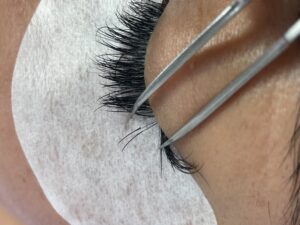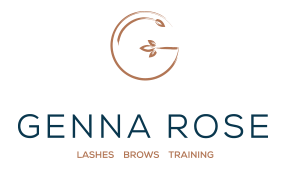Throughout this guide, we’ll be focussing on patch testing for eyelash extensions, discussing what it is, how it works and why you don’t always have to have one when getting eyelash extensions.
What’s a patch test?
A patch test is simply a preventative measure used by beauty therapists, lash & brow artists and even hairdressers, to determine if a client is allergic to any of the products used throughout their treatment. Whilst most but not all treatments require a patch test, it is important to understand what is required before proceeding with any treatment. The last thing anyone wants is for you to have a reaction or to be uncomfortable.
Is a patch test needed for eyelash extensions?
This is a controversial subject. and one that will vary from lash artist to lash artist. Typically, it is advisable to conduct a patch test for safety and as a cautionary measure. However, it is all down to what both yourself and your lash artist feel comfortable with. Once your lash artist has a good understanding of your medical background, your lifestyle and has explained in depth how eyelash extension products work and react, only then can you make a combined decision on if a patch test is necessary for you.
How does a patch test work?
There is no right or wrong way to conduct a patch test for eyelash extensions and in fact, you’ll get different opinions from different people. Most lash artists are testing to see if you have a reaction to the adhesive, and not testing all the other products being used throughout the treatment, such as cleanser, primers, bonders and even the eye pads.
One way to conduct a patch test is to apply individual eyelash extensions to the outer edges of your natural lashes.
Another method used is applying a small amount of glue behind the ear.
Let’s look at those two methods in more detail.
Applying a few lashes Vs testing on the skin
Cyanoacrylate is the main ingredient in lash adhesive and the reason for most reactions. It is an irritant for your skin, eyeballs, and respiratory functions. For this reason, lash adhesives should not touch the skin, ever. Testing on the skin is the old school method for patch testing and is not a clear indicator for showing if a reaction will occur or not. Applying a few lashes also DOES NOT give a clear indication of whether a reaction will occur. This is because of 2 reasons.
- A patch test does not give full exposure in the same way a full set will.
- Lash adhesive allergies are cumulative (they build up over time).
It is more likely for allergies, sensitivities, and reactions to occur in clients that have been having lashes for 6 months or more than in first timers!
As stated above, either method of patch testing will not give enough exposure to the eyes, lashes and respiratory functions in the same way that doing a full set would. This means that a small patch test will not accurately test for allergies and a reaction could still occur even if the patch test results are fine.
Most of the time, reactions happen in clients that have been having lashes applied for a longer period of time. This is because the sensitivity will build up each time the client is exposed to lash adhesive. It is unlikely (although it is possible) that a client will already have an allergy to Cyanoacrylate if they have not been exposed to it before.
A true patch test
A true patch test is testing every product that you plan to use on that specific client. Lashes, adhesive, eye pads, cleanser, primer, tape etc. Do you know the problem with a “true patch test”? It still would not give full exposure and even IF a reaction did occur, you would then have to determine which product it was that is causing the problem!
With that being said, not having a patch test isn’t an option for everyone. Depending on your medical background, your lifestyle and your personal choice, a patch test will be non negotiable and you may even be advised that lash extensions aren’t the right treatment for you.
Adhesive ingredients
The main ingredient in lash adhesive is a product call, Cyanoacrylate. Carbon black is another ingredient present within adhesives which gives the adhesive their black colour. If you’re allergic to carbon black, a clear adhesive can be used as an alternative. Stabilisers are also present in eyelash adhesive to improve the longevity and the drying time of the product. Fun fact: Nail Glue and Super Glue are also Cyanoacrylate based.
Cyanoacrylate allergy
If you are allergic to Cyanoacrylate, unfortunately, you will not be able to have lash extensions done. That said, most reactions / sensitivities are due to the vapours that come off the adhesive. The moisture in the eye naturally attracts the vapours and can cause sensitisation. Therefore, it is very important to have air movement at the point of application, moving the vapours away from your eyes. Otherwise, vapours will fall back onto the face if not moved away. They will fall particularly to the eye area due to the moisture.
How can I prevent a reaction occurring?
In previous years, it was recommended that we tell clients not to get their lashes wet for 24-48 hours to allow the bond to finish its curing process and aid retention. We disagree! Cyanoacrylate adhesives loves moisture
Our adhesive cures from the outside in, therefore it is effectively dry within seconds of application. This is due to the minimal amount of glue used to bond the natural eyelash and the eyelash extension. The complete bonding process from the adhesive being a liquid to a solid bond can take up to 60 minutes, even using just a tiny amount. This process is called polymerisation. Most adhesive will have a drying time between 0.5-3 seconds.
As we have discussed, the adhesive cures from the outside in and we can absolutely get the eyelashes wet after application, however, we do need to wait a few minutes to prevent shock curing, before we do so. Post washing can be a refreshing way to end the treatment, it cleanses the eye area, reduces any fumes around the eye area which will also help reduce the risk of a reaction, it speeds up the bonding process and leaves you feeling refreshed. It will also help if you take off the clothes worn at your appointment, pop them in the wash, and even wash your hair/ take shower, as extreme as it may sound, this will remove the vapour particles and will help in preventing a reaction. Remember: once a reaction has occurred, there is no going back.
Things to know
Not all adhesive manufacturers require or recommend needing a patch test when using their adhesives, but for manufactures that recommended you to patch test with their products,
manufacturing guidelines should always be followed.
Don’t be offended if your lash artist advises you not to have eyelash extensions, they will only have your best interests at heart.
Please note: Patch tests are non-negotiable for lash lifting, tinting, henna brows and brow lamination treatments.
Get in touch to get further advice or to book an appointment.




